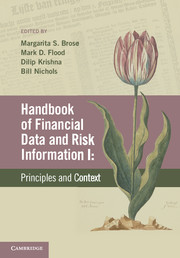Book contents
- Frontmatter
- Contents
- List of contributors
- Preface
- VOLUME I: PRINCIPLES AND CONTEXT
- PART I RISK MANAGEMENT CONTEXT FOR FINANCIAL DATA
- 1 A brief history of financial risk and information
- 2 Risk management
- 3 Portfolio risk monitoring
- 4 Frameworks for systemic risk monitoring
- 5 Data-driven regulation and financial reform: one perspective from industry on the financial crisis
- PART II REQUIREMENTS AND SOURCES FOR FINANCIAL RISK MANAGEMENT
- PART III REGULATORY DATA
- Index – Volume I
- References
1 - A brief history of financial risk and information
from PART I - RISK MANAGEMENT CONTEXT FOR FINANCIAL DATA
- Frontmatter
- Contents
- List of contributors
- Preface
- VOLUME I: PRINCIPLES AND CONTEXT
- PART I RISK MANAGEMENT CONTEXT FOR FINANCIAL DATA
- 1 A brief history of financial risk and information
- 2 Risk management
- 3 Portfolio risk monitoring
- 4 Frameworks for systemic risk monitoring
- 5 Data-driven regulation and financial reform: one perspective from industry on the financial crisis
- PART II REQUIREMENTS AND SOURCES FOR FINANCIAL RISK MANAGEMENT
- PART III REGULATORY DATA
- Index – Volume I
- References
Summary
This chapter presents the historical context for the current state of financial information and risk management. At any point in time, the institutions and practices that constrain financial behavior are just the latest point in an evolutionary process along a single historical path. Our basic understanding of events is subject to this path dependence too. Keynes (1936, p. 383) notes that, “Practical men, who believe themselves to be quite exempt from any intellectual influences, are usually the slaves of some defunct economist.” In tracing events over the longer term, the rhymes of history begin to emerge. There are recurring dynamics and episodic patterns that make history something more than mere chronology. Reinhart and Rogoff (2009), for example, mock the perennial speculator's incantation that “this time is different” with a sobering litany of inancial over-enthusiasms that have ended in tears.
On the other hand, the world has indeed changed over the long run. As we write this, the global inancial system is still emerging from the catastrophic events of 2007–2009. While one of this chapter's central goals is to demonstrate that many of the features of the recent crisis have historical antecedents, events that may appear to be defining characteristics of the latest trauma – such as interconnectedness, technological sophistication, and world-wide impact – are in fact the manifestations of broader historical trends that have been at work for decades or centuries. This is clearly true of the four thematic dimensions I emphasize below: institutionalization, globalization, technology, and complexity.
- Type
- Chapter
- Information
- Handbook of Financial Data and Risk Information IPrinciples and Context, pp. 8 - 32Publisher: Cambridge University PressPrint publication year: 2014
References
- 2
- Cited by



